Charles E W Bean, Diaries, AWM38 3DRL 606/259/1 - 1917 - 1927 - Part 15
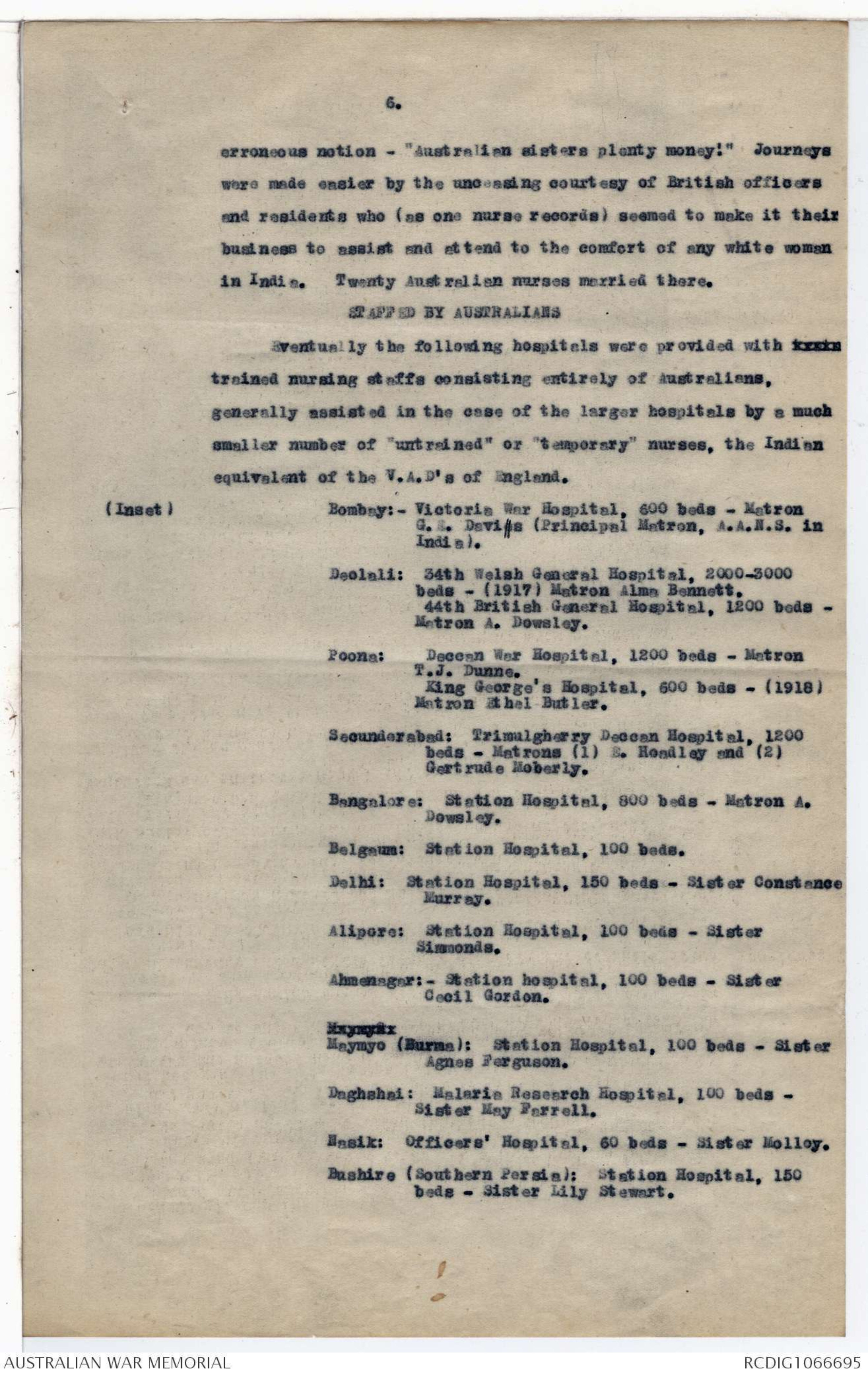
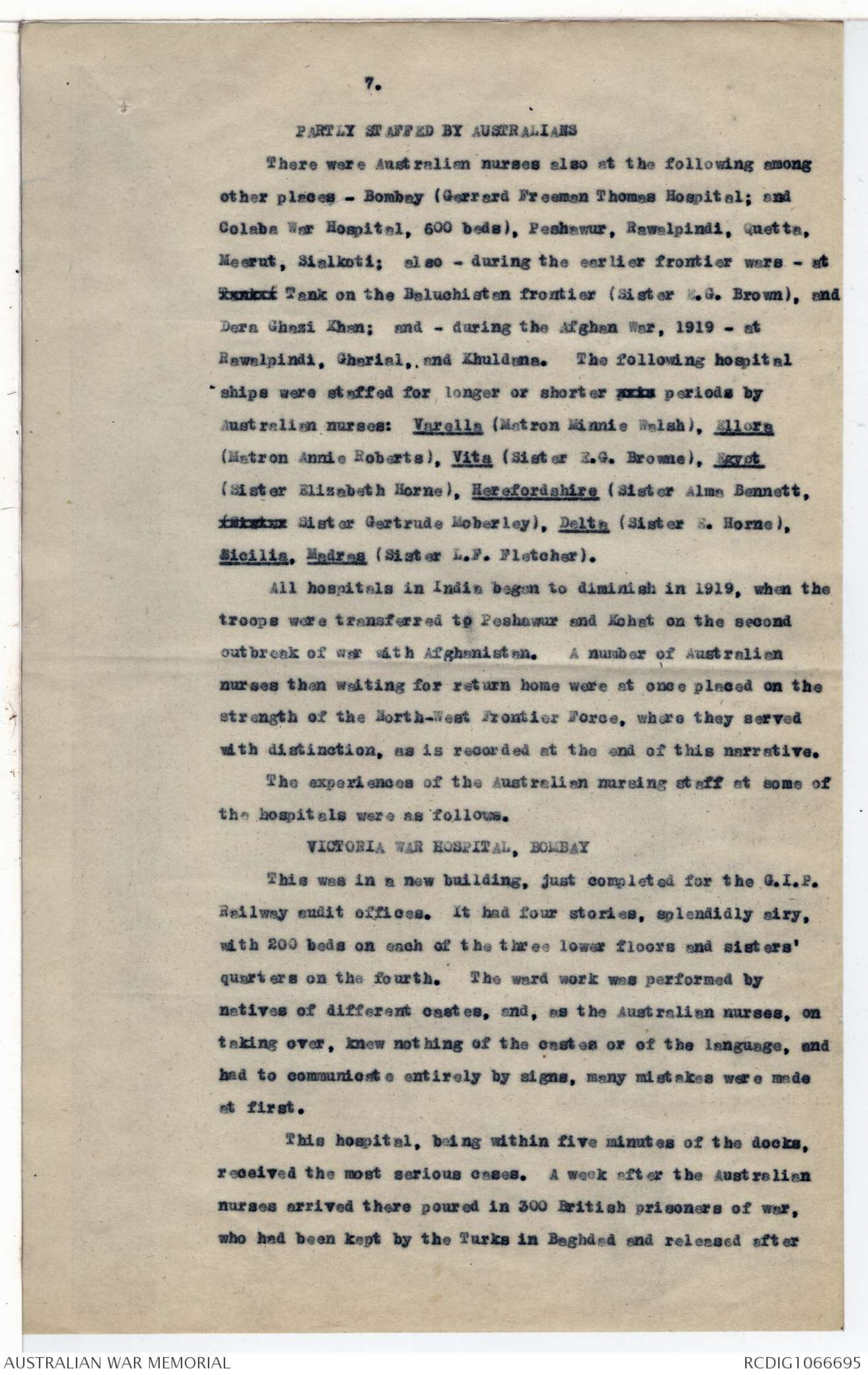
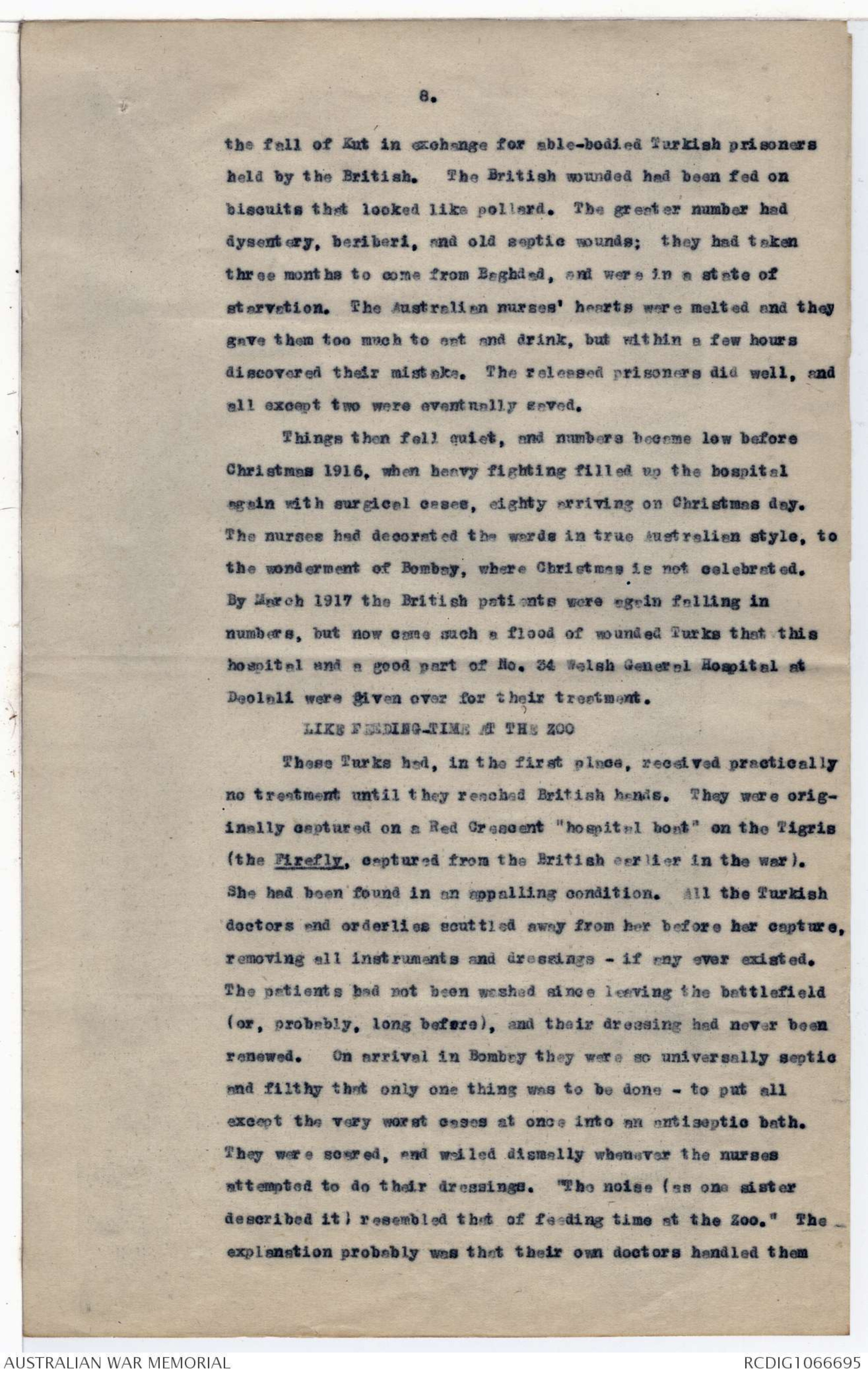
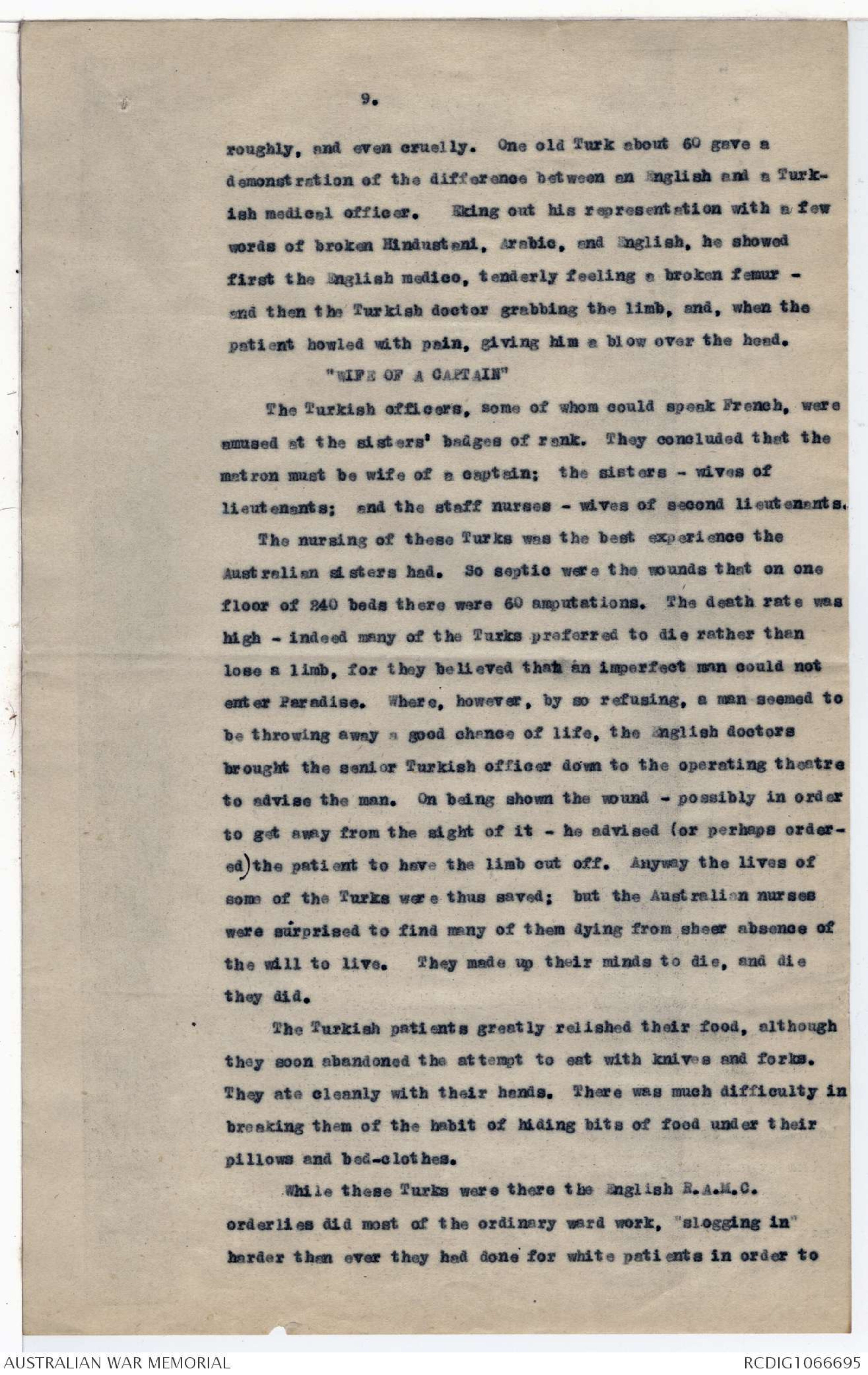


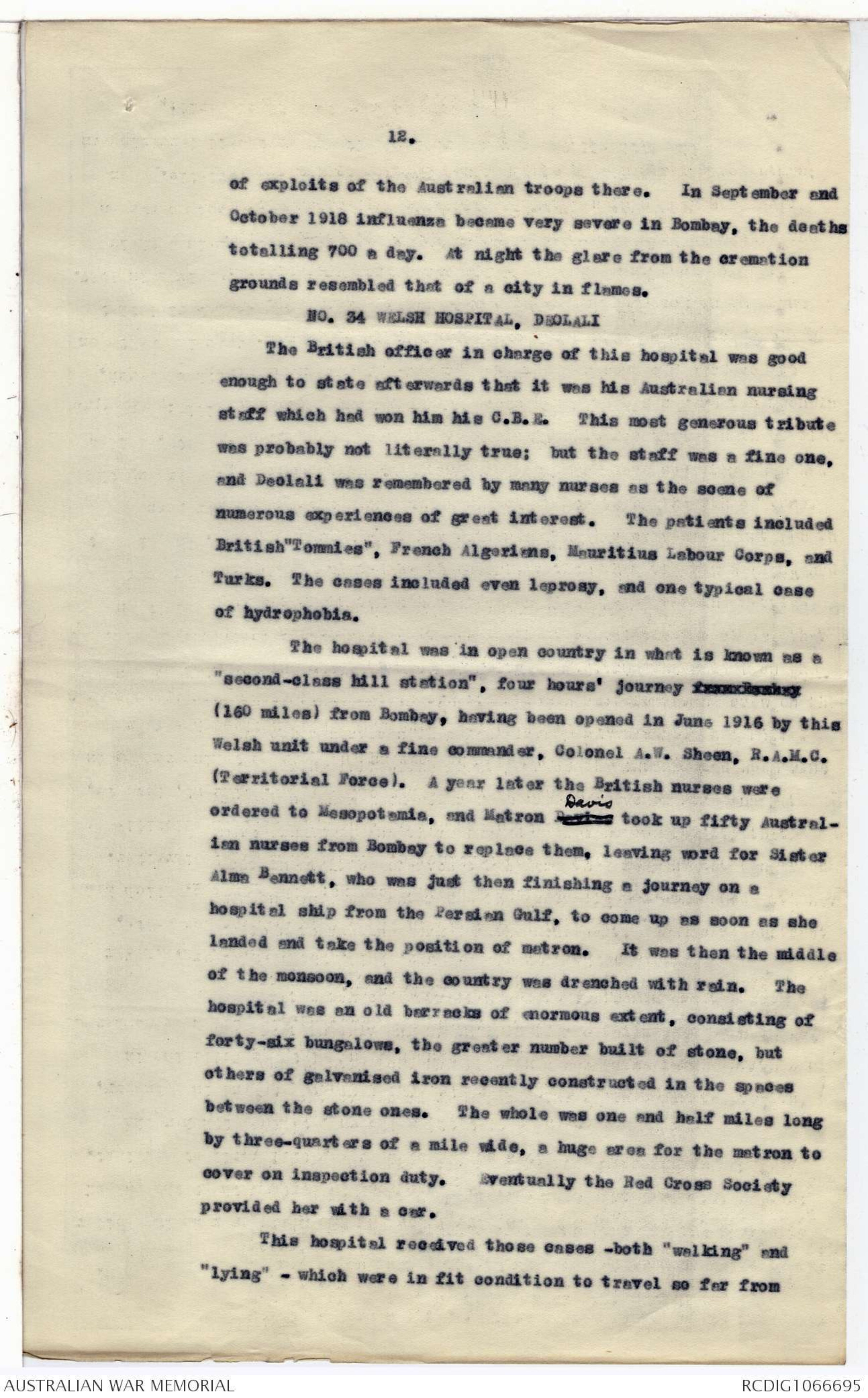
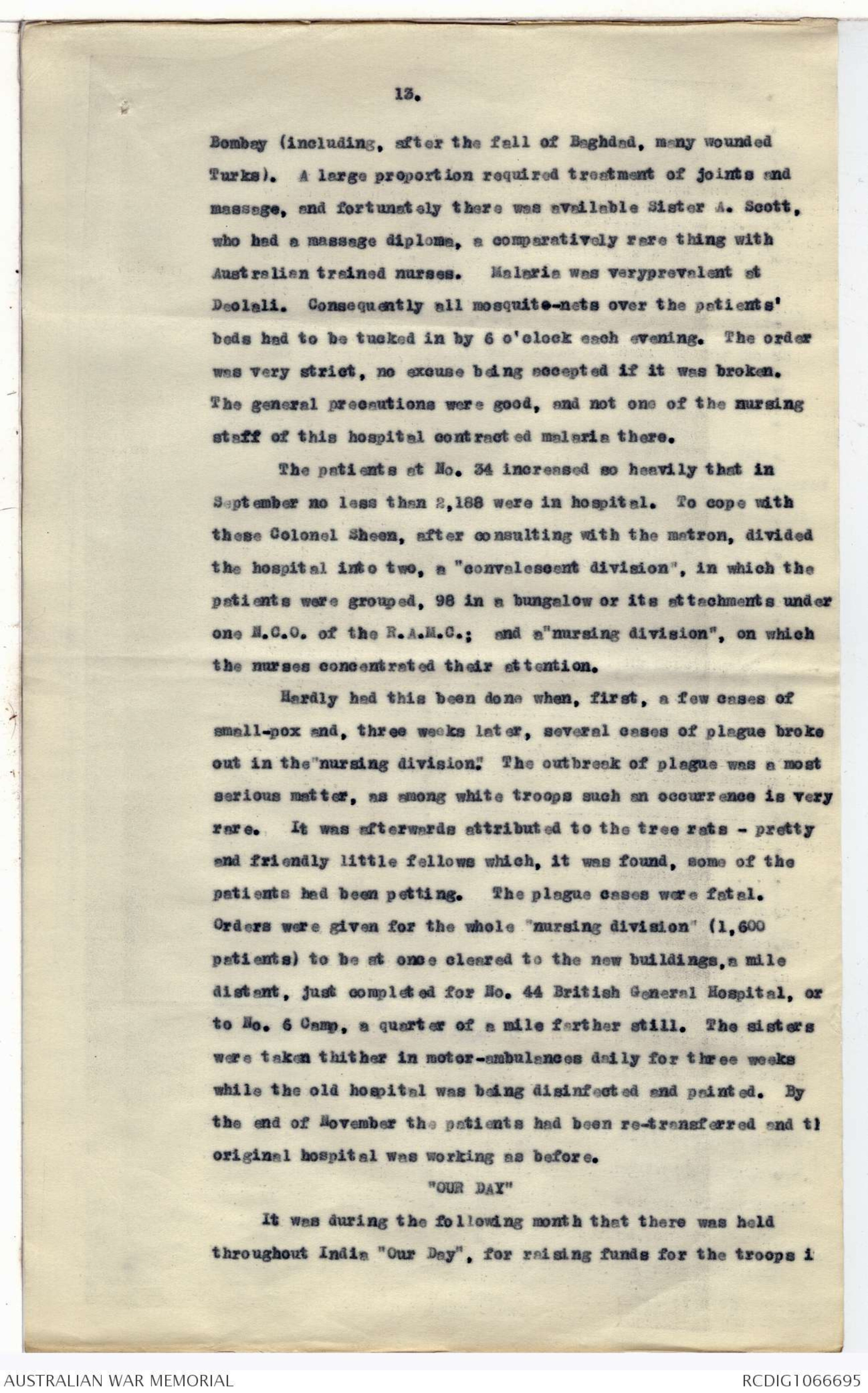
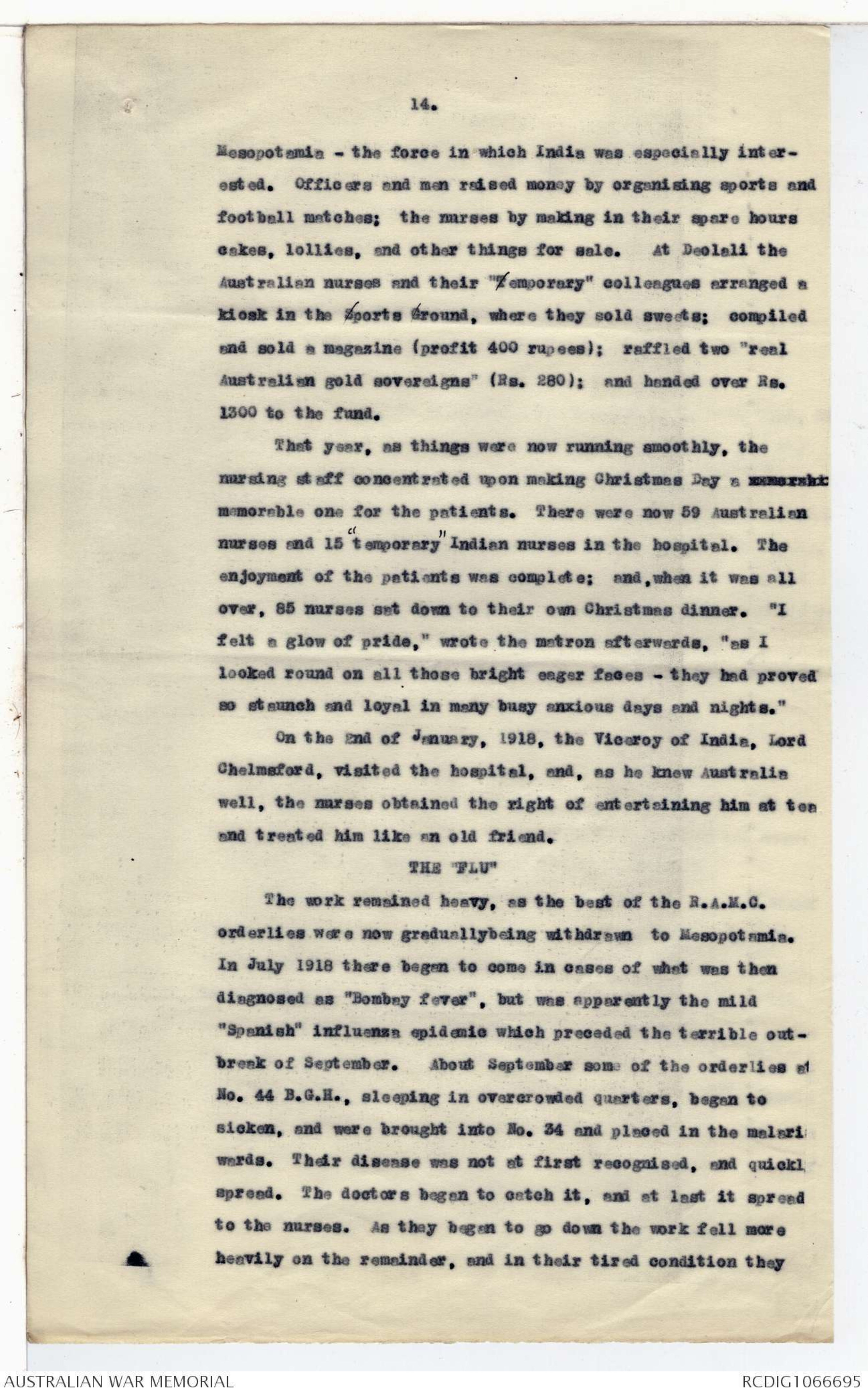
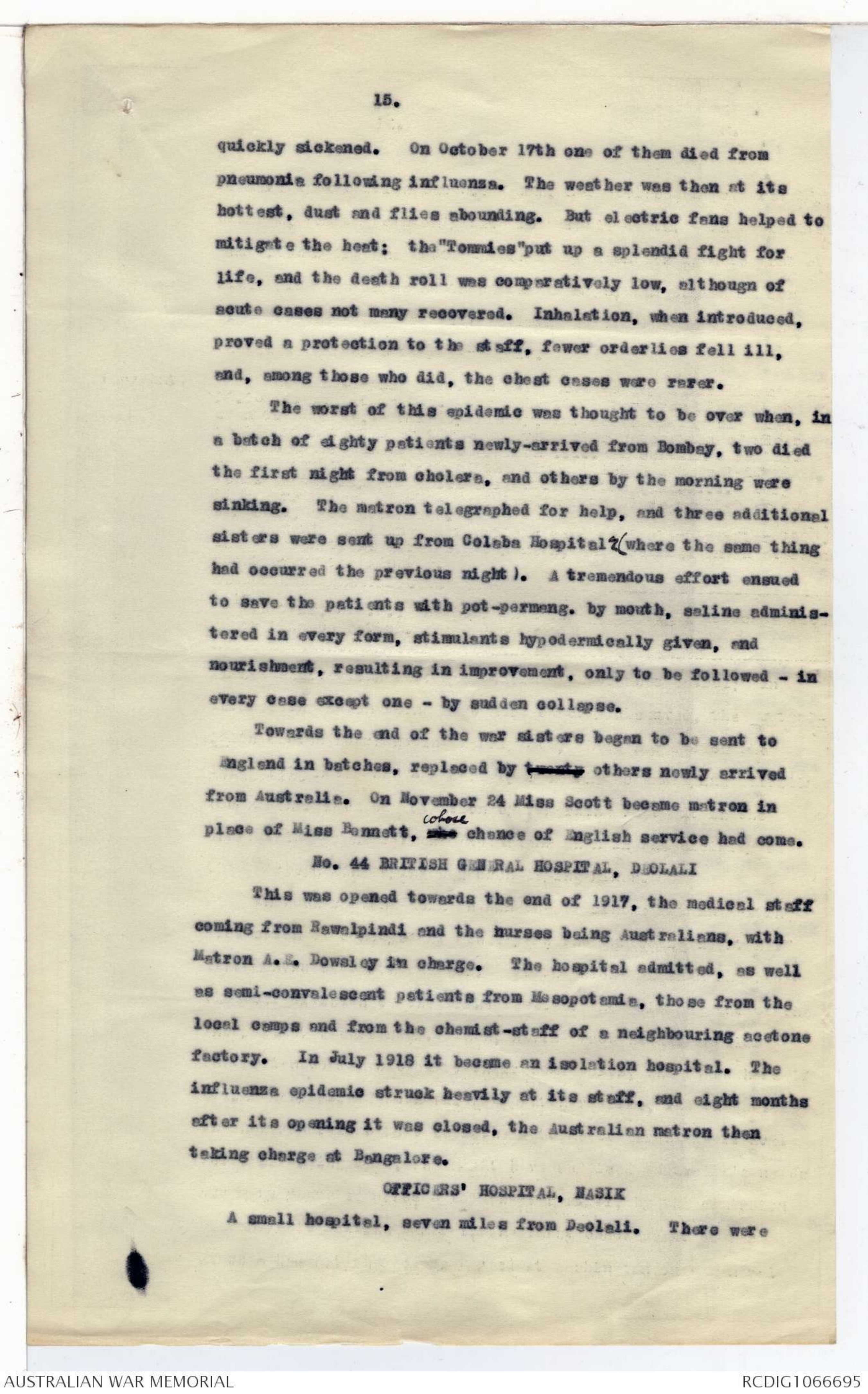
6.
erroneous notion -"Australian sisters plenty money!" Journeys
were made easier by the unceasing courtesy of British officers
and residents who (as one nurse records) seemed to make it their
business to assist and attend to the comfort of any white woman
in India. Twenty Australian nurses married there.
STAFFED BY AUSTRALIANS
Eventually the following hospitals were provided with xxxxx
trained nursing staffs consisting entirely of Australians,
generally assisted in the case of the larger hospitals by a much
smaller number of "untrained" or "temporary" nurses, the Indian
equivalent of the V.A.D's of England.
Bombay:- Victoria War Hospital, 600 beds - Matron
G.E. Davies (Principal Matron, A.A.N.S. in
India).
Deolali: 34th Welsh General Hospital, 2000-3000
beds - (1917) Matron Alma Bennett.
44th British General Hospital, 1200 beds -
Matron A. Dowsley.
Poona: Deccan War Hospital, 1200 beds - Matron
T.J. Dunne.
King George's Hospital, 600 beds - (1918)
Matron Ethel Butler.
Secunderabad: Trimulgherry Deccan Hospital, 1200
beds - Matrons (1) E. Hoadley and (2)
Gertrude Moberly.
Bangalore: Station Hospital, 800 beds - Matron A.
Dowsley.
Belgaum: Station Hospital, 100 beds.
Delhi: Station Hospital, 150 beds - Sister Constance
Murray.
Alipore: Station Hospital, 100 beds - Sister
Simmonds.
Ahmenagar:- Station hospital, 100 beds - Sister
Cecil Gordon.knorrå
Maymyo (Burma): Station Hospital, 100 beds - Sister
Agnes Ferguson.
Daghshai: Malaria Research Hospital, 100 beds.
Sister May Farrell.
Nasik: Officers' Hospital, 60 beds - Sister Molloy.
Bushire (Southern Persia): Station Hospital, 150
beds - Sister Lily Stewart.
7.
PARTLY STAFFED BY AUSTRALIANS
There were Australian nurses also at the following among
other places - Bombay (Gerrard Freeman Thomas Hospital; and
Colaba War Hospital, 600 beds), Peshawur, Rawalpindi, Quetta,
Meerut, Sialkoti; also - during the earlier frontier wars - atxxxxx Tank on the Baluchisten frontier (Sister E.G. Brown), and
Dera Ghazi Khan; and - during the Afghan War, 1919 - at
Rawalpindi, Gharial, and Khuldana. The following hospital
ships were staffed for longer or shorter xxxx periods by
Australian nurses: Varella (Matron Minnie Walsh), Ellora
(Matron Annie Roberts), Vita (Sister E.G. Browne), Egypt
(Sister Elizabeth Horne), Herefordshire (Sister Alma Bennett,xxxxx Sister Gertrude Moberley), Delta (Sister S. Horne),
Sicilia, Madras (Sister L.F. Fletcher).
All hospitals in India began to diminish in 1919, when the
troops were transferred to Peshawur and Kohat on the second
outbreak of war with Afghanistan. A number of Australian
nurses then waiting for return home were at once placed on the
strength of the North-West Frontier Force, where they served
with distinction, as is recorded at the end of this narrative.
The experiences of the Australian nursing staff at some of
the hospitals were as follows.
VICTORIA WAR HOSPITAL, BOMBAY
This was in a new building, just completed for the G.I.P.
Railway audit offices. It had four stories, splendidly airy,
with 200 beds on each of the three lower floors and sisters'
quarters on the fourth. The ward work was performed by
natives of different castes, and, as the Australian nurses, on
taking over, knew nothing of the castes or of the language, and
had to communicate entirely by signs, many mistakes were made
at first.
This hospital, being within five minutes of the docks,
received the most serious cases. A week after the Australian
nurses arrived there poured in 300 British prisoners of war,
who had been kept by the Turks in Baghdad and released after
6.
the fall of Kut in exchange for able-bodied Turkish prisoners
held by the British. The British wounded had been fed on
biscuits that looked like pollard. The greater number had
dysentery, beriberi, and old septic wounds; they had taken
three months to come from Baghdad, and were in a state of
starvation. The Australian nurses' hearts were melted and they
gave them too much to eat and drink, but within a few hours
discovered their mistake. The released prisoners did well, and
all except two were eventually saved.
Things then fell quiet, and numbers became low before
Christmas 1916, when heavy fighting filled up the hospital
again with surgical cases, eighty arriving on Christmas day.
The nurses had decorated the wards in true Australian style, to
the wonderment of Bombay, where Christmas is not celebrated.
By March 1917 the British patients were again falling in
numbers, but now came such a flood of wounded Turks that this
hospital and a good part of No. 34 Welsh General Hospital at
Deolali were given over for their treatment.
LIKE FEEDING-TIME AT THE ZOO
These Turks had, in the first place, received practically
no treatment until they reached British hands. They were
originally captured on a Red Crescent "hospital boat" on the Tigris
(the Firefly, captured from the British earlier in the war).
She had been found in an appalling condition. All the Turkish
doctors end orderlies scuttled away from her before her capture,
removing all instruments and dressings - if any ever existed.
The patients bed not been washed since leaving the battlefield
(or, probably, long before), and their dressing had never been
renewed. On arrival in Bombay they were so universally septic
and filthy that only one thing was to be done - to put all
except the very worst cases at once into an antiseptic bath.
They were scared, end wailed dismally whenever the nurses
attempted to do their dressings. "The noise (as one sister
described it) resembled that of feeding time at the Zoo." The
explanation probably was that their own doctors handled them
9.
roughly, and even cruelly. One old Turk about 60 gave a
demonstration of the difference between an English and a
Turkish medical officer. Eking out his representation with a few
words of broken Hindustani, Arabic, and English, he showed
first the English medico, tenderly feeling a broken femur -
and then the Turkish doctor grabbing the limb, and, when the
patient howled with pain, giving him a blow over the head.
"WIFE OF A CAPTAIN"
The Turkish officers, some of whom could speak French, were
amused at the sisters' badges of rank. They concluded that the
matron must be wife of a captain; the sisters - wives of
lieutenants; and the staff nurses - wives of second lieutenants.
The nursing of these Turks was the best experience the
Australian sisters had. So septic were the wounds that on one
floor of 240 beds there were 60 amputations. The death rate was
high - indeed many of the Turks preferred to die rather than
lose a limb, for they believed that an imperfect man could not
enter Paradise. Where, however, by so refusing, a man seemed to
be throwing away a good chance of life, the English doctors
brought the senior Turkish officer down to the operating theatre
to advise the man. On being shown the wound - possibly in order
to get away from the sight of it - he advised (or perhaps ordered)
the patient to have the limb cut off. Anyway the lives of
some of the Turks were thus saved; but the Australian nurses
were surprised to find many of them dying from sheer absence of
the will to live. They made up their minds to die, and die
they did.
The Turkish patients greatly relished their food, although
they soon abandoned the attempt to eat with knives and forks.
They ate cleanly with their hands. There was much difficulty in
breaking them of the habit of hiding bits of food under their
pillows and bed-clothes.
While these Turks were there the English R.A.M.C.
orderlies did most of the ordinary ward work, "slogging in"
harder than ever they had done for white patients in order to
10.
save the sisters. The night orderlies refused to go to their
dining room for supper because it would mean leaving the sister:
alone in the wards. The Turks were easy to manage: but more
than one broke a crutch over a fellow countryman's head through
a quarrel at cards.
HEAT-STROKE
From March to July 1917 there were never less than 500
Turks at this hospital. Then they were sent to Deolali, and
the Victoria Hospital was being prepared for native troops,
when there arrived a flood of British cases with heat-stroke -
nearly 1,000 per week for three months; and they were pouring
into all the other Bombay hospitals also. All were very
anaemic, most had heart trouble, and many developed severe
epilepsy, which was often relieved by a lumbar puncture. One
patient had a temperature of 109, and when ice-sponging and
packs were tried he only came down to 106 and stayed there for
three days! He got well, but was a very long time about it.
The moist heat of the Gulf often caused prickly heat, which
became septic and developed into boils: many patients were
literally covered with them. All heat-strokes were eventually
sent for three months to the hills.
By October 1917 German prisoners from East Africa were
arriving. British, German, and Turks were all well disciplined
and not once was any sister subjected to the least disrespect.
"I have the greatest admiration for the endurance of the British:
Tommy," wrote one sister (Sister Alma Bennett), "and the
orderlies, with rare exceptions, were invaluable." The hospital
closed on the 5th of August, 1918.
CUMBALLA WAR HOSPITAL
This hospital was beautifully sited on Malabar Hill, by t!
shores of Bombay harbour. It had 600 beds, and the patients
were British soldiers and Turkish prisoners. The staff was for
a time a mixed one of English and Australian nurses under a
British matron, but it was shortly afterwards decided that the
11.
Australian sisters should where possible serve under Australian
matrons.
COLABA WAR HOSPITAL
Twenty minutes' drive from Bombay city. The hospital
consisted of old bungalows, which at first appeared very
unsuitable but afterwards proved comfortable enough. The staff
was a mixed one, including regular Anglo-Indian nurses
(G.A.I.M.N.S.) and temporary nurses, with R.A.M.C. orderlies:
but the greater part of the nursing staff consisted of
Australian sisters under an English matron, Miss Knapp, "whom we all
adored," as one of the Australian sisters afterwards wrote.
"I have never met her equal for organising power," records
another. Consequently, in spite of the steamy heat and
inevitable loss of energy, the nurses were happy - "like one happy
family", as another Australian girl states. The Australian
sisters quickly gathered enough Hindustani to manage the native
servants. The hospital was soon in order: it had the sea on
three sides of it, and the officers' wards were beautifully
furnished, as were also those for the sick sisters. The
patients were mainly from the British garrison of India. In
the later part of the service there patients brought in with
"malaria" were found to be really suffering from cholera,
smallpox, and plague. "So our experience was very varied," comments
an Australian sister (Miss Larkin).
GERRARD FREEMAN THOMAS HOSPITAL
This was in a fine building constructed for a school of
science. The hospital was founded by Lady Willingdon, wife of
the Governor of Bombay, and was named after their son, who was
killed in the retreat from Mons. Lady Willingdon had supervise
the furnishing, which was finely done. Here twelve of the staf
of fifty nurses were Australian. There were no R.A.M.C?
orderlies, but Indian ward-boys. The cases (1,000 beds) were
British, including some ^Australian wireless boys from Mesopotamia, and
many Lancashire, Welsh, and Scottish troops who had served in
Gallipoli and who regaled the nurses with fine tales
12.
of exploits of the Australian troops there. In September and
October 1918 influenza became very severe in Bombay, the deaths
totalling 700 a day. At night the glare from the cremation
grounds resembled that of a city in flames.
NO. 34 WELSH HOSPITAL, DEOLALI
The British officer in charge of this hospital was good
enough to state afterwards that it was his Australian nursing
staff which had won him his C.B.E. This most generous tribute
was probably not literally true: but the staff was a fine one,
and Deolali was remembered by many nurses as the scene of
numerous experiences of great interest. The patients included
British "Tommies", French Algerians, Mauritius Labour Corps, and
Turks. The cases included even leprosy, and one typical case
of hydrophobia.
The hospital was in open country in what is known as a
"second-class hill station", four hours' journey xxxxxxxxxxx
(160 miles) from Bombay, having been opened in June 1916 by this
Welsh unit under a fine commander, Colonel A.W. Sheen, R.A.M.C.
(Territorial Force). A year later the British nurses were
ordered to Mesopotamia, and Matron Davies Davis took up fifty
Australian nurses from Bombay to replace them, leaving word for Sister
Alma Bennett, who was just then finishing a journey on a
hospital ship from the Persian Gulf, to come up as soon as she
landed and take the position of matron. It was then the middle
of the monsoon, and the country was drenched with rain. The
hospital was an old barracks of enormous extent, consisting of
forty-six bungalows, the greater number built of stone, but
others of galvanised iron recently constructed in the spaces
between the stone ones. The whole was one and half miles long
by three-quarters of a mile wide, a huge area for the matron to
cover on inspection duty. Eventually the Red Cross Society
provided her with a car.
This hospital received those cases -both "walking" and
"lying" - which were in fit condition to travel so far from
13.
Bombay (including, after the fall of Baghdad, many wounded
Turks). A large proportion required treatment of joints and
massage, and fortunately there was available Sister A. Scott,
she had a massage diploma, a comparatively rare thing with
Australian trained nurses. Malaria was veryprevalent st
Deolali. Consequently all mosquito-nets over the patients'
bods had to be tucked in by 6 o'clock each evening. The order
was very strict, no excuse being accepted if it was broken.
The general precautions were good, and not one of the nursing
staff of this hospital contracted malaria there.
The patients at No. 34 increased so heavily that in
September no less than 2,188 were in hospital. To cope with
these Colonel Sheen, after consulting with the matron, divided
the hospital into two, a "convalescent division", in which the
patients were grouped, 98 in a bungalow or its attachments under
one N.C.O. of the R.A.M.C.; and a"nursing division", on which
the nurses concentrated their attention.
Hardly had this been done when, first, a few cases of
small-pox and, three weeks later, several cases of plague broke
out in the "nursing division." The outbreak of plague was a most
serious matter, as among white troops such an occurrence is very
rare. It was afterwards attributed to the tree rats - pretty
and friendly little fellows which, it was found, some of the
patients had been petting. The plague cases were fatal.
Orders were given for the whole "nursing division" (1,600
patients) to be at once cleared to the new buildings,a mile
distant, just completed for No. 44 British General Hospital, or
to No. 6 Camp, a quarter of a mile farther still. The sisters
were taken thither in motor-ambulances daily for three weeks
while the old hospital was being disinfected and painted. By
the end of November the patients had been re-transferred and th
original hospital was working as before.
"OUR DAY"
It was during the following month that there was held
throughout India "Our Day", for raising funds for the troops i
14.
Mesopotamia - the force in which India was especially
interested. Officers and men raised money by organising sports and
football matches; the nurses by making in their spare hours
cakes, lollies, and other things for sale. At Deolali the
Australian nurses and their "Temporary" colleagues arranged a
kiosk in the Sports Ground, where they sold sweets; compiled
and sold a magazine (profit 400 rupees): raffled two "real
Australian gold sovereigns" (Rs. 280); and handed over Rs.
1300 to the fund.
That year, as things were now running smoothly, the
nursing staff concentrated upon making Christmas Day a xxmarxk
memorable one for the patients. There were now 59 Australian
nurses and 15 "temporary" Indian nurses in the hospital. The
enjoyment of the patients was complete: and, when it was all
over, 83 nurses sat down to their own Christmas dinner. "I
felt a glow of pride," wrote the matron afterwards, "as I
looked round on all those bright eager faces - they had proved
so staunch and loyal in many busy anxious days and nights."
On the End of January, 1918, the Viceroy of India, Lord
Chelmsford, visited the hospital, and, as he knew Australia
well, the nurses obtained the right of entertaining him at ten
and treated him like an old friend.
THE "FLU"
The work remained heavy, as the best of the R.A.M.C.
orderlies wore now graduallybeing withdrawn to Mesopotamia.
In July 1918 there began to come in cases of what was then
diagnosed as "Bombay fever", but was apparently the mild
"Spanish" influenza epidemic which preceded the terrible
outbreak of September. About September some of the orderlies at
No. 44 B.G.H., sleeping in overcrowded quarters, began to
sicken, and were brought into No. 34 and placed in the malaria
wards. Their disease was not at first recognised, and quickl
spread. The doctors began to catch it, and at last it spread
to the nurses. As they began to go down the work fell more
heavily on the remainder, and in their tired condition they
15.
quickly sickened. On October 17th one of them died from
pneumonia following influenza. The weather was then at its
hottest, dust and flies abounding. But electric fans helped to
mitigate the heat; the "Tommies" put up a splendid fight for
life, and the death roll was comparatively low, although of
acute cases not many recovered. Inhalation, when introduced,
proved a protection to the staff, fewer orderlies fell ill,
and, among those who did, the chest cases were rarer.
The worst of this epidemic was thought to be over when, in
a batch of eighty patients newly-arrived from Bombay, two died
the first night from cholera, and others by the morning were
sinking. The matron telegraphed for help, and three additional
sisters were sent up from Colaba Hospital (where the same thing
had occurred the previous night). A tremendous effort ensued
to save the patients with pot-permeng. by mouth, saline
administered in every form, stimulants hypodermically given, and
nourishment, resulting in improvement, only to be followed - in
every case except one - by sudden collapse.
Towards the end of the war sisters began to be sent to
England in batches, replaced by t-otbers others newly arrived
from Australia. On November 24 Miss Scott became matron in
place of Miss Bennett, whose xxx chance of English service had come.
No. 44 BRITISH GENERAL HOSPITAL, DEOLALI
This was opened towards the end of 1917, the medical staff
coming from Rawalpindi and the Nurses being Australians, with
Matron A.S. Dowsley in charge. The hospital admitted, as well
as semi-convalescent patients from Mesopotamia, those from the
local camps and from the chemist-staff of a neighbouring acetone
factory. In July 1918 it became an isolation hospital. The
influenza epidemic struck heavily at its staff, and eight months
after its opening it was closed, the Australian matron then
taking charge at Bangalore.
OFFICERS' HOSPITAL, NASIK
A small hospital, seven miles from Deolali. There were
 Sam scott
Sam scottThis transcription item is now locked to you for editing. To release the lock either Save your changes or Cancel.
This lock will be automatically released after 60 minutes of inactivity.